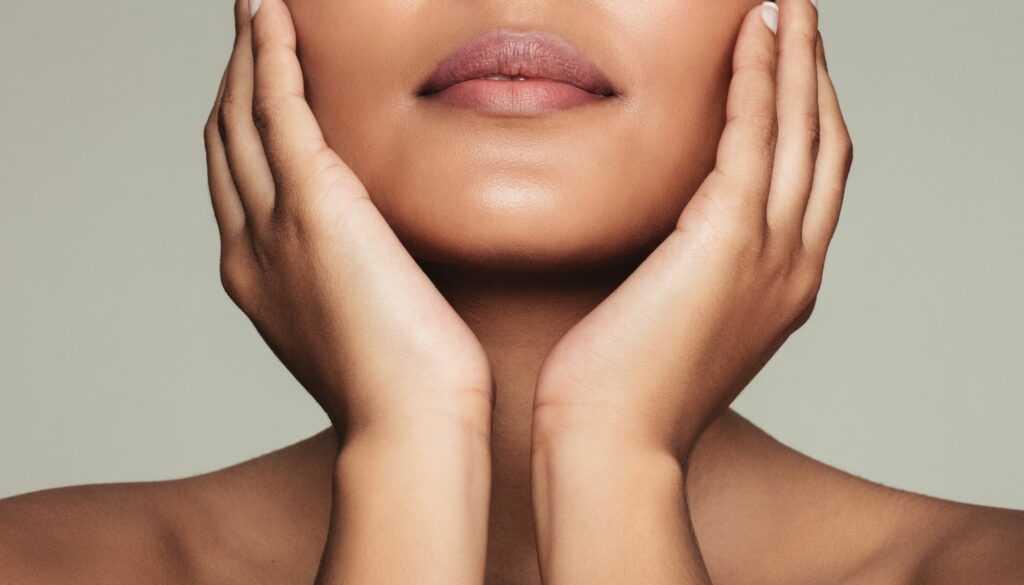Does pesky peach fuzz get in the way of your foundation? Is your skin craving a rejuvenating exfoliation? Dermaplaning is an easy way to both remove the top layer of dead skin cells from your face as well as get rid of any hair. Best of all, this procedure can be done in the comfort of your home.
What is Dermaplaning?
Dermaplaning uses a single blade (a small facial razor) to scrape dead skin cells and hair off the surface of your face.
Potential Benefits of Dermaplaning:
- Improve skin texture (can help with acne scars, dry skin, and wrinkles)
- Glowing skin
- Provides a smooth base for makeup
- Helps better absorb skincare products
Dermaplaning is often done professionally, but doing it at home has been growing in popularity. When done by a licensed professional, they use a surgical-grade scalpel or a straight-edge razor. This typically costs anywhere from $45 – $140.
For at home dermaplaning, we highly recommend picking a safe dermaplaning set or product that anyone can safely use. These can be purchased on Amazon for affordable prices.
Many people use eyebrow razors that are very affordable, but there are also higher-end products (like the StackedSkincare Dermaplaning tool or the Dermaflash Luxe) that are specifically made for dermaplaning and are more effective. These tools will help you get a deeper exfoliation.
How to Dermaplane at Home
Follow these steps for a quick, simple, and non-irritating dermaplaning experience:
Before Dermaplaning
There are some precautions to take before your dermaplaning session. First, it’s recommended to avoid waxing the area you plan to dermaplane seven days before.
Three days before, you will also want to avoid bleaching and tweezing your face. Try to stay out of the sun and make sure to wear a broad-spectrum sunscreen daily. You will also want to stop using products that contain the following ingredients at least three days before you plan to dermaplane:
- Glycolic acid
- Retinols and retinoids
- Salicylic acid
- Alpha hydroxy acid
These precautionary steps will help make sure you have a smooth dermaplaning session that is irritation-free.
Cleanse
Now that you’re ready to start an actual dermaplaning session at home, it’s always best to start with a clean canvas.
Simply use your favorite cleanser to thoroughly wash your face, removing ALL make-up debris before going in with your blade.
Dry Your Face
Pat your skin dry.
For effective results, it’s best to get your skin as dry as possible—this will make it easier for the scalpel to remove dry skin and hair.
Dermaplaning
Pull your skin taut and gently scrape downwards in small strokes, making sure the blade is connecting at a 45-degree angle. Make sure to scrape downwards to avoid irritation.
To avoid irritation and possible damage, avoid eyelids, the sides of your nose, and your hairline. You should see little clumps of peach fuzz collecting as your blade moves downwards!
Aftercare
After you’re done lightly shaving, make sure to hydrate your skin with your favorite facial serum and a moisturizer.
Exfoliation can make skin hyper-sensitive to UV rays, so make sure to apply an SPF if you’re planning to go outside. Better yet, try to avoid direct sunlight for the next day or two if possible. You will also want to avoid chlorine and any type of facial exfoliating product.
Make sure not to apply makeup right after dermaplaning as your skin is going to be a little sensitive. You will want to wait 24–48 hours to apply makeup, otherwise you may experience breakouts.
Dermaplaning FAQ
How Often Can I Dermaplane?
The ideal frequency of dermaplaning depends on your skin type. Dermatologists typically recommend every 2 or 3 weeks, but definitely don’t do it more than once a week.
If you’re having dermaplaning done professionally, once a month is ideal (since this treatment is typically more intense than at home).
Can Dermaplaning Be Bad for Your Skin?
There are a few circumstances where dermaplaning might not turn out as amazing for you. Those with dry skin, sensitive skin, or rosacea can experience irritation. Dermaplaning has the potential to damage the moisture barrier of your skin,
It’s also not recommended if you have any cold sores or acne (especially hormonal or cystic acne). Dermaplaning can spread this bacteria throughout the face. Although dermaplaning can improve acne scars, it’s not a great treatment for those with acne.
Is Dermaplaning Just Shaving?
A lot of people think dermaplaning is just a fancy word for shaving your face, but it does a bit more than shaving hair. It removes dead skin cells to help even out skin tone and texture.
Professional dermaplaning uses a surgical-grade scalpel to scrape off years of dead skin (better than can be done with regular exfoliation). That said, we wouldn’t recommend a surgical scalpel when dermaplaning at home unless you’re a professional.
Bottom Line
Overall, dermaplaning is an easy procedure that can be done from the comfort of your home! There is a myth that your hair will grow back thicker and more stubbly if you shave it, but there is no data to back this. It should maintain the same peach-fuzzy, pre-shaven texture.
For best results, repeat this process every 2–3 weeks. You should see your skin looking brighter and more rejuvenated over time.
Not ready to put a blade to your face? You can try exfoliating with a konjac sponge, a facial cleansing brush, or simply finding your perfect exfoliating cleanser. While it may not show as powerful results as dermaplaning, these methods can help brighten your skin and make it glow, so they’re worth giving a shot!

